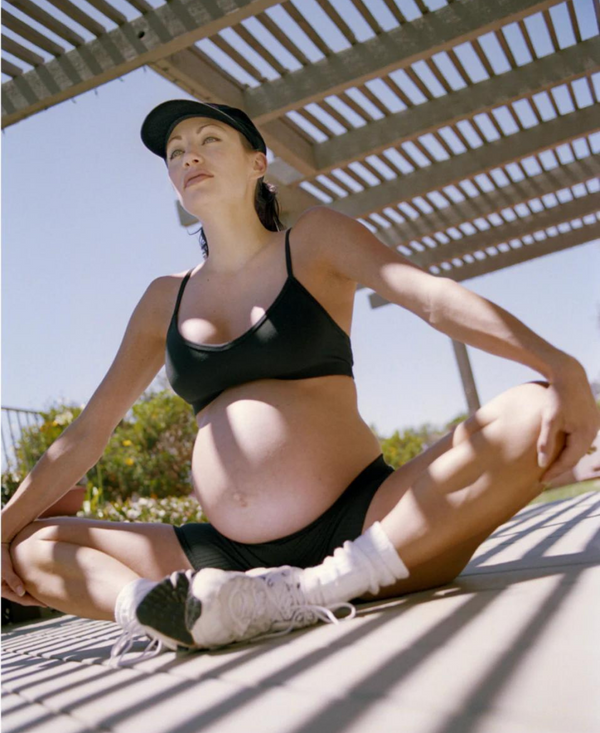Talking All Things Pelvic Health with Physio Julie B.

We’re sitting down with Julie Bagshaw, Registered Physiotherapist (and mom of two!) to talk all things Pelvic Health.
Julie, a lifelong fitness enthusiast, is a Certified Management Accountant -turned-Physiotherapist with a specialization in pelvic floor physiotherapy. She has advanced training in treating diastasis recti, incontinence, prolapse, pelvic pain, blocked ducts, constipation, pelvic girdle pain, labour and delivery preparation and pregnancy-related dysfunction. She also focuses on treating pelvic floor conditions in high-intensity athletes.
(Sonday) So, tell me what I need to know about Pelvic Health.
(Julie) Pelvic Health is an area of focus in physiotherapy that has become increasingly popular in the past 10-15 years in North America, however other areas of the world such as Europe have been studying and treating the pelvic floor for much longer. In my mind, it is one of the most important areas of the body because when something is wrong with the pelvic floor, it can significantly affect your quality of life (think peeing when you cough, pain with sex, inability to walk while pregnant) .
Pelvic floor physiotherapy as a practice involves assessing and treating various conditions that involve the pelvic floor muscles and/or symptoms that manifest in the region of the pelvis.
What the heck is your pelvic floor, and what do we need to know about it?
Your pelvic floor (PF) is a group of muscles that run approximately where your underwear sits. The muscles run from your pubic bone at the front to your tailbone at the back. They also connect to either side of your sitz bones to create a bowl of muscles at the bottom of your pelvis.
They perform many important functions such as assisting with bladder, bowel and sexual function. They provide support to many vital organs (bladder, bowel, uterus) and are the foundation of our ‘core’ muscles. The pelvic floor, along with the diaphragm and deep abdominal/back muscles, helps us to manage pressure in our abdomen and support/stabilize our spine.
It’s important that your pelvic floor muscles, just like all muscles in our body, can contract and relax and that they have the flexibility, endurance and power to keep up with the demand you place on your body. This is true for everyone- we all have a pelvic floor! This can be a challenge sometimes as we cant see these muscles and many people dont even know they exist. Additionally, pregnancy is a big risk factor for pelvic floor dysfunction. This is where pelvic floor physiotherapists come in- to educate, coach and empower people to use these muscles in a better way to eliminate their symptoms and get back to the activities they want to be doing.

What are the most common misconceptions about Pelvic Health? Is pelvic health only for expectant and new mothers?
We get asked this a lot! And no! Pelvic Floor work is for people of any age and stage who are experiencing pelvic floor related issues. It’s just that childbearing and child birth can be a risk factor for pelvic floor dysfunction so many people think that these are the only individuals who should attend. In addition to treating adults, I also treat kiddos who are having pelvic floor issues after around the age of 5.
In terms of misconceptions, most often I get asked whether women should attend pelvic physiotherapy if they’ve had a c-section. The answer is yes! While it’s true that having a c-section doesnt affect the pelvic floor as much as a vaginal birth, the imapct of carrying a baby for 40+ weeks can be significant. The change in center of gravity, body weight and growing abdominal wall can affect your ability to use your core muscles, can change your posture/breathing/walking pattern and place a large amount of effort on your pelvic floor muscles in the process which can cause dysfunction.
I think they next most common question I get is whether people should wait to do pelvic physiotherapy after they’ve had a baby. The answer to this is a big no! Think about training for your delivery like you would train for a marathon. You wouldnt just wake up one day and run 42.2km! It’s important to do some preparation to determine how ready your body and pelvic floor are to give birth and start doing exercises in advance to prepare. Typically, recovering is much easier if you have a better connection to your pelvic floor muscles in advance.
Tell me about your journey from CMA to Physiotherapist, and your interest in specializing in Pelvic Health?
I have an undergraduate degree from Waterloo in math and business, and worked in Finance for 7 years. When my work days became 10-12 hours long, I started to wonder if this was the best long term path for me given my desire for better work/life balance and what I’m truly passionate about, which is fitness, food & health.
I was in my late 20s and decided to look into work that aligned more closely with my passion to help people live their best lives. I applied and got into the Physiotherapy program at MacMaster University in Hamilton, ON, which takes two years to complete.
During my time there I had an instructor who was extremely passionate about pelvic health. She made me realize I could make a meaningful impact and difference in people’s lives with this type of physiotherapy which really resonated with me.
After graduation I worked for a year practicing general physiotherapy (referred to as orthopaedics), which involved working with patients to improve function after, say, an injury or surgery. I learned a lot in this year, but quickly realized that I wanted to practice in an area that was more meaningful to me and to spend more time with clients to get to know them better and be able to make a more meaningful impact.
As a result, I decided to switch my focus to pelvic health. The model of care in this area typically means I get to spend a lot more 1:1 time with my clients which allows me to understand them more holistically and achieve better results.
Issues in pelvic health are often caused by broader health issues and are interconnected wiht the state of your body. Are you stressed? What is your general diet and fitness actility like? Do you get enough sleep? As a pelvic physiotherapist, I assess the person as a ‘whole’ to come up with the best plan to address their issues.
My job is to talk to clients, try my best to understand them as a ‘whole’ and then I can help offer the best treatment options for who they are as individuals, from sleeping to eating and everything in between. This way to work with clients was deeply appealing to me, being able to help people from the inside out, and on a more personal and relationship-focused level.
What types of symptoms do you typically treat?
I see all types of issues ranging from:
- People preparing for or healing from childbirth
- Pain during sex
- Incontinence while walking or running
- Being unable to “hold it”
- Pain in the low back/pelvis
- Prolapse
- Diastasis
- Blocked milk ducts
How have you and your colleagues been treating clients throughout the pandemic?
The pandemic has been a struggle for everyone, but it has also created access to new platforms for virtual care which is really exciting. I work at Vital Physiotherapy & Wellness in Toronto, and we have remained open to see clients at our clinic for most of the pandemic. However, we were very quick to add virtual treatment options to our practice so that we could continue to provide care for our clients. We have had tremendous results with our virtual care sessions and still incorporate it into most of our clients treatment plan.
I was “scared” about trying it out when I was pregnant, even though I heard it was so helpful. What do you share with women to help them get over the hesitancy of coming in for a consultation?
I always want my clients to understand that we are here to help you understand your body and get back to living a life free from pain and concerns.
The most common concern I hear (and completely understand) is that many of these issues are difficult to talk about, especially to a new healthcare provider. It can feel embarrassing to share things like ‘I pee myself when I go for a run’.
It’s also as an area that's seen as ‘private’, and the thought of having an internal exam makes people anxious.
The great thing is that pelvic physiotherapists are actually able to do so much without an internal exam. Most clients benefit from educaiton about how the body and pelvic floor actually work and how dysfunction in this area relate to their symptoms. Next, external exams of breathing, posture, gait, functional movements such as squats and planks can all give helpful information on where to start for treatment. External assessments of the pelvic floor can also give quite a bit of information (aka assessment of the pelvic floor where the physio just uses gentle touch of the pelvic floor while you are completely dressed). We work at the pace you’re willing to work at, and never push you to do more.
Is there a “best time” to start, and end, your pelvic health work as an expectant and new mom?
As an expectant mom, if you're not having any issues or feeling anything unusual, I suggest getting in touch around the 20-week mark to ensure everything is progressing well.
At that point we assess and check in to see: what is the status of my PF? My core? What are my goals for labour and deliver? And we take it from there.
If you come in around that 20-week mark and we determine there are some issues to work on, then we have lots of time to assess and treat things to make sure you have a healthier labour, and this means a better recovery. But! You can really come in any time with issues or just to check-in.
We usually do specific labor & delivery prep sessions around 34-37 weeks to provide education about the birth process and to help you start thinking about positions, breathing and strategies to help relax and release to ensure an easier birth.
After giving birth, you want to give yourself a minimum of 6 weeks to heal before coming in (longer if you have a C-Section). When you feel ready and able after that, you can call anytime to start up the next set of sessions.
Why does Canada seem to lag behind Europe and other countries in the importance of pelvic health and awareness?
The area of Pelvic Health has not been part of traditional physiotherapy education here in Canada until recently. It was an area that was not well studied and understood, and had little focus. The majority of research and leading edge studies had been conducted historically by European and Australian practitioners. However, we are starting to see a lot more clinical experts from Canada conducting research in this area - which is very motivating and exciting for all of our local practitioners. This research and learning is now helping shape the curriculum taught across Canadian physiotherapy programs, so I’m thrilled to see what’s to come in the future in this area.
How did awareness of Pelvic Health start to gain in importance and popularity?
People started to realize that traditional physiotherapy exercises were not correcting issues such as Prolapse (when you feel as though your insides are falling out of your body) and Diastasis (a separation of your abdominal muscles). So patients would go back to their doctors with the same issues. Many doctors would prescribe surgery, but unfortunately these werent 100% successful either. Traditional solutions were simply not working and people facing pelvic floor issues deserved better.
Pelvic health practitioners are more able to understand and correct these issues because of their advanced manual skills and understanding of how to train and strengthen these muscles to correct these types of concerns.
What is the best piece of knowledge you’d like to leave women with regarding their personal pelvic health?
You don’t have to live in pain or with incontinence, prolapse or diastasis! These types of issues dont just arise because you had a baby or you are getting older.
If something doesn’t feel right and you haven’t been able to get help from your physician or other practitioners, try locating a pelvic physiotherapist in your area to find out how you can eliminate your symptoms and get back to living your best life! For a local directory, you can go to www.pelvichealthsolutions.ca and go to ‘Find A Health Care Professional’.
Contact Julie!
Julie is currently on maternity leave with her second child but will resume her work at Vital Physiotherapy & Wellness in early 2022.
She also has her own in-home practice Simply Pelvic Physiotherapy & Wellness and can be contacted in early 2022 for booking inquiries at julie@simplypelvic.ca
Julie holds her CPA, CMA and MSc PT.



